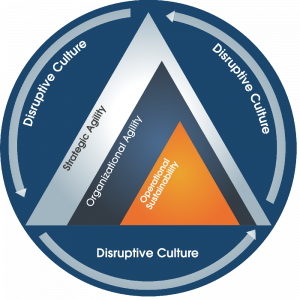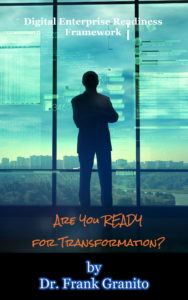Digital Readiness Framework:
History and References
History of the Framework Development
The Digital Readiness Framework was developed by the Institute for Digital Transformation. The initial idea came from Charles Araujo during a routine operational assessment for a client. Charlie broke the assessment into non-traditional areas which were later evolved into the Attributes of the Operational Sustainability Dimension by Dr. Frank Granito. Dr. Granito possesses extensive academic and research experience in organizational theory and culture, particularly in organizational transformation.
For over a decade, the Institute had actively been engaged with organizations, assisting them in their IT and Digital Transformation journeys. During this period, the Institute collected valuable data regarding the factors that either facilitated or obstructed the success of these transformational programs. This accumulated data and experience laid the groundwork for the Framework.
The Institute has also conducted or been a part of multiple research projects. One such project delved into the nuanced differences between “Digital Transformation” and “IT Transformation.” By amalgamating this research data with the previously collected operational data, Dr. Granito created the Digital Readiness Framework. The framework is designed to gauge and benchmark an organization’s preparedness to successfully undertake a digital transformation initiative.
The resulting Digital Readiness Framework offers an analytical method to evaluate an organization’s readiness across four key dimensions:

Operational Sustainability:
Does your organization have a stable base to operate from?
Organizational Agility:
How quickly can your organization react to change?
Strategic Agility:
How well does your organization anticipate change?
Disruptive Culture:
How receptive is your organization to implementing change?
The primary objective of the Framework is to provide a methodological method to measure an organization’s capability to initiate and successfully execute a digital transformation effort.
In addition to the operational data, the development of the Framework’s Characteristics and Attributes was based on information from various research materials, including works by renowned authors and scholars in the fields of managerial decision-making, strategic management, organizational culture and leadership, strategic agility, and more.
References
- Bazerman, Max, and Don A. Moore. Judgment in Managerial Decision Making. 8th ed. John Wiley & Sons, 2013.
- Hunger, J. D., & Wheelen, T. L. (2003). Essentials of strategic management. New Jersey: Prentice Hall.
- Schein, E. H. (2006). Organizational culture and leadership (Vol. 356). John Wiley & Sons.
- Long, C. (2000). Measuring your strategic agility. Consulting to Management, 11(3), 25.
- Doz, Y. L., & Kosonen, M. (2010). Embedding strategic agility: A leadership agenda for accelerating business model renewal. Long range planning, 43(2), 370-382.
- Wendler, R. (2014, September). Development of the organizational agility maturity model. In Computer Science and Information Systems (FedCSIS), 2014 Federated Conference on (pp. 1197-1206). IEEE.
- Lukas, B. A., Whitwell, G. J., & Heide, J. B. (2013). Why do customers get more than they need? How organizational culture shapes product capability decisions. Journal of Marketing, 77(1), 1-12.
- Crocitto, M., & Youssef, M. (2003). The human side of organizational agility. Industrial Management & Data Systems, 103(6), 388-397.
- Digital and IT Transformation: A global View of Trends and Requirements, EMA, 2015
- Granito, Francis A. University of Maryland University College, ProQuest Dissertations Publishing, 2011. 3509189.
Even More Information
 If you want to understand every detail about the Digital Readiness Framework, the best source is to purchase the book that Dr. Granito wrote about the Framework. In addition to general information about the Framework, the book has one chapter dedicated to each Dimension. In these chapters, a description of each of the Attributes along with its purpose is provided. Dr. Granito then further breaks down each Attribute into its component Characteristics.
If you want to understand every detail about the Digital Readiness Framework, the best source is to purchase the book that Dr. Granito wrote about the Framework. In addition to general information about the Framework, the book has one chapter dedicated to each Dimension. In these chapters, a description of each of the Attributes along with its purpose is provided. Dr. Granito then further breaks down each Attribute into its component Characteristics.
The book is available in the Amazon Kindle store.
Premium Institute Members can DOWNLOAD the book for free.
Summary
In essence, the history of the Framework development is a testament to a comprehensive and collaborative effort, combining practical experience with academic research to create a robust tool for assessing digital readiness.
The Digital Readiness Framework was the basis for the development of the analytical model of the heart of the Digital Transformation Readiness Tool. Learn More
